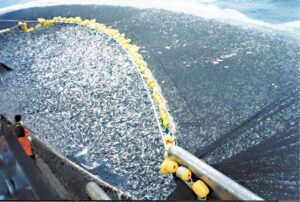A shift in financing can make our fisheries more sustainable
 5 November 2020
5 November 2020
Our oceans provide around 90 million tons of wild-captured seafood each year. Fishing communities, businesses and consumers alike rely on healthy ecosystems and fisheries to continue to source, sell and eat fish.
Unfortunately, over a third of the world’s fisheries have been overexploited and the health of the ecosystems on which they depend is in decline. Despite these realities, seafood still holds much promise. The World Bank has indicated that fishery production globally could be worth $83 billion more each year if fisheries were managed at sustainable levels.

Fisheries are an inherently renewable resource. They can provide more fish, guarantee more predictable and resilient incomes, and deliver higher environmental benefits if we invest in their recovery and continued management. At present, Fishery Improvement Projects (FIPs) – many of which work towards third party certification – are a primary mechanism for achieving these goals.
However, funding for FIPs comes predominantly from governmental and philanthropic sources, and it is inadequate for the major work needed. Given competing priorities in the philanthropic sector and pressure to reduce public spending, we urgently need other sources of capital.
In response, Ocean Outcomes (O2) and the World Wide Fund for Nature (WWF) are at the forefront of developing a solution – a proposed Sustainable Seafood Fund (SSF or Fund). The Fund is designed to overcome current implementation and funding hurdles by providing a vehicle for both impact investors and seafood companies to invest in FIPs and help scale sustainability initiatives.
The Fund is based on the business case for seafood companies to invest in programs aimed at improving the long-term viability of their seafood supplies. Under the Fund’s proposed model, industry partners support the improvement of fisheries that supply them through a volume-based fee, while investors support improvement by pooling capital in a return-making financing mechanism that advances funds for those improvements.
This vehicle provides a much-needed platform to ensure accountability, scale up financing for fisheries recovery, reduce transaction costs and achieve economies of scale. It also ensures attainment of environmental, social and livelihood goals, in alignment with United Nations’ Sustainable Development Goal 14. Central to the success of this model is a pipeline of investment-grade FIPs.
As part of the development of the SSF, we have worked with a cross section of professionals in the legal and financial community to identify the attributes of investment-grade FIPs. We have identified the following attributes as critical for ensuring accountability, mitigating risks and achieving target impact objectives:
- Landings commensurate with the level of investment proposed must be possible without pushing the fishery into an overfished state.
- Agreed objectives, a supporting workplan and budget must be in place, with externally verifiable indicators, and the goal of achieving GSSI benchmarked certification.
- Reputable and creditworthy seafood companies willing to enter into contractual agreements to support the above objectives and assure investors that they will be repaid.
At a minimum, there should be adequate volumes available to ensure the viability of the financing model and company engagement that do not endanger the fishery or contribute to overfishing. If there are adequate volumes available to deliver the returns necessary, these must then be evaluated against the risks of climate change impacts and stock dynamics to better understand the risk for investors.
Objectives, workplans and budgets are necessary to provide a baseline, ensure accountability and to secure private sector participation. They will also form the basis of the engagement captured in company agreements and help ensure alignment amongst relevant stakeholders, which includes supply chain partners, relevant non-profit organizations and relevant government entities. To qualify for funding, participants must agree to an annual audit of the progress of the workplan against the agreed baseline.

Currently, developing objectives, workplan and budget are a central part of existing FIP guidelines and methodology, as defined by the Conservation Alliance for Seafood Solutions.
These guidelines provide an accepted framework for working towards becoming an investment-grade FIP. Note that currently these guidelines are focused primarily on environmental opportunities, but are being updated to incorporate social and economic dimensions.
The companies sourcing from a fishery must have a vested interest in ensuring fisheries are sustainably utilized – both from a short term market access perspective, and from a long term supply chain reliability perspective. The number of private sector partners participating in the fishery is an important component.
While agreeing to terms with one partner may be easier, agreement with multiple partners increases the likelihood of ongoing support (instead of relying on one line of support, there’s a net). Other key elements to consider are whether the businesses will: agree to the objectives and priority investments defined in the FIP workplan and budget; contribute to the cost of the necessary improvements in the fishery (or currently do so); and, commit to a minimum purchase volume and fee and to preferentially source from the fishery.
As part of the design process for the proposed Fund, we have compiled a list of over 250 fisheries of interest. While we have been able to identify a pipeline of opportunities, these currently amount to fewer than 7% of the 250. Most FIPs lack fully vetted financials, have limited or unclear landing volumes, have varied and disparate workplans, or have not developed robust industry supporters. To realize blue finance investments in sustainable fisheries, addressing these challenges should be a priority for future capacity building and grant making.
Collectively, those working in fishery improvement need to pursue achieving clearer, consistent fishery data through more robust stock assessments which support aggregation of universally adopted key data elements. Those developing FIPs need to ensure budgets, workplans and objectives are developed using agreed upon templates and guidance, much of which is already available on FisheryProgress.org.
We need to demand transparency surrounding vessel participation and fishery production volumes. As we work to improve the quality and consistency of FIPs, we need to nurture private sector interest in fishery improvement, highlighting the needs and opportunities of investing in sustainable seafood production to our industry partners.
If we can collectively work towards these goals, we will begin to attract the private capital necessary to support the fisheries reform we all seek.
The post A shift in financing can make our fisheries more sustainable appeared first on Sustainability Times.
